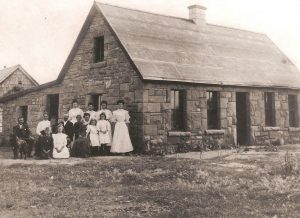
Since St. Patrick’s Day occurs this month, it’s the perfect time to feature an Irish immigrant to Glenbow: William John Doherty. Whether William possessed the fabled luck of the Irish is debatable, but as it turns out, luck plays a part in my story.
Arriving in Canada in 1889, 26-year-old William was a talented stonecutter. In 1891, he won the Calgary Exhibition’s first and second prizes for ornamental stonecutting, where the clock stand he carved, “presented a pretty appearance.” That year, when his young family arrived, William took up a homestead near Bowden, Alberta.
While proving up his homestead, William left occasionally to work in his trade, and as time passed he was absent with increasing frequency. However, he did eventually replace his log house with a beautifully-worked stone home for his wife and their thirteen children.
According to his family, William helped construct Calgary’s Queen’s Hotel, Post Office, Great West Saddlery, King Edward Hotel extension, and Public Library. He also worked on the Innisfail Methodist church, the Lethbridge Bank of Montreal, and the Olds Victoria Hotel. Smaller scale projects included the baptismal font in Innisfail’s St. Mark’s Anglican Church, and gravestones in the Innisfail and Bowden districts.
William also contributed to two Calgary buildings made with Glenbow sandstone — the Land Titles building and City Hall. In fact, William’s name appears on the list of men who were working at City Hall on September 15, 1908 when the cornerstone was laid.
A dedicated stonecutter, William became deeply involved in the growing labour movement of the time. He was one of twelve founding members and the secretary/treasurer of the Stonecutters’ Union Calgary branch and later became vice-president. He also served as president of the Calgary Trades and Labour Council.
In 1909, William’s skill as a stonecutter earned him a new job. He was appointed government inspector at Glenbow Quarry, charged with ensuring that the quarry company cut stone to contract specifications for important government buildings, including the Alberta Legislature. However, the company owners had “grave complaints” against him, and he was perceived as “undermining the quarry company’s authority” — perhaps because of his unionist leanings. In the interests of speeding up the delivery of sandstone, the government cancelled the position of quarry inspector in 1910, and William again moved on.
By 1920, William was completely estranged from his family, and knowledge of his later years is punctuated only by the final note that at his death he had been serving as postmaster of a small BC town.
While the demise of his family-life could be seen as the ultimate misfortune, William was lucky enough to have many descendants. By the centenary of his arrival in Canada, thirty-three years ago, his direct descendants numbered 13 children, 29 grandchildren, 81 great-grandchildren, 158 great-great-grandchildren, and 22 great-great-great-grandchildren. I’m sure the current count is significantly higher.
At this point in researching William Doherty’s life, I found my pot of gold.
I had been asked to submit an article to a historical society’s newsletter to promote my new book Alberta’s Cornerstone: Archaeological Adventures in Glenbow Ranch Provincial Park. The title refers to the book’s main message: Glenbow Quarry represents the foundation of modern Alberta because its stone created important buildings, and because its people made significant contributions to society.
The story featured in the article needed to be fresh and needed to tie in with the book’s theme. I was already working on a new article about William Doherty, and as it turned out, the Doherty descendant I had contacted provided the critical piece of information revealing William’s unique legacy.
Through a quirk of fate, a grandson of William Doherty attained the pinnacle of local political success in the very building William was constructing out of Glenbow sandstone when its cornerstone was laid: Calgary City Hall. Donald Hugh Mackay became Calgary’s 26th mayor, serving from 1950-59. Mackay defined the Calgarian identity by inaugurating the White Hat Ceremony, wherein assorted dignitaries are gifted a white Smithbilt cowboy hat in a celebration of western hospitality. Surely, William would have appreciated the cultural significance of this embodiment of fellowship.
Happy St. Patrick’s Day!
P.S. My new book Alberta’s Cornerstone: Archaeological Adventures in Glenbow Ranch Provincial Park, published by Heritage House will be released May 3 and is available for pre-order from your favourite bookseller. Visit my website sharipeyerl.ca for more information about the book and to read about other Glenbow residents.
This article was originally printed in THE BERGEN NEWS and is being reprinted with permission.